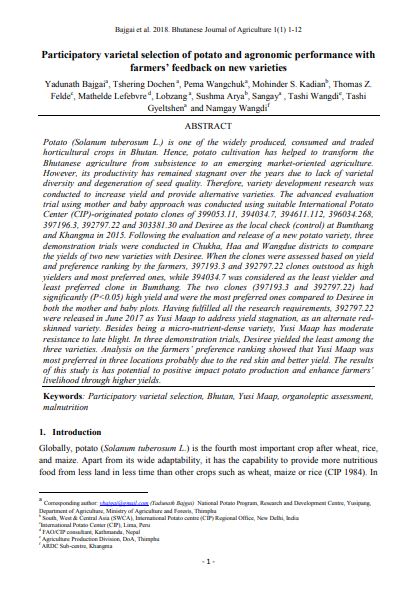Participatory varietal selection of potato and agronomic performance with farmers’ feedback on new varieties.
Abstract
Potato (Solanum tuberosum L.) is one of the widely produced, consumed and traded horticultural crops in Bhutan. Hence, potato cultivation has helped to transform the Bhutanese agriculture from subsistence to an emerging market-oriented agriculture. However, its productivity has remained stagnant over the years due to lack of varietal diversity and degeneration of seed quality. Therefore, variety development research was conducted to increase yield and provide alternative varieties. The advanced evaluation trial using mother and baby approach was conducted using suitable International Potato Center (CIP)-originated potato clones of 399053.11, 394034.7, 394611.112, 396034.268, 397196.3, 392797.22 and 303381.30 and Desiree as the local check (control) at Bumthang and Khangma in 2015. Following the evaluation and release of a new potato variety, three demonstration trials were conducted in Chukha, Haa and Wangdue districts to compare the yields of two new varieties with Desiree. When the clones were assessed based on yield and preference ranking by the farmers, 397193.3 and 392797.22 clones outstood as high yielders and most preferred ones, while 394034.7 was considered as the least yielder and least preferred clone in Bumthang. The two clones (397193.3 and 392797.22) had significantly (P<0.05) high yield and were the most preferred ones compared to Desiree in both the mother and baby plots. Having fulfilled all the research requirements, 392797.22 were released in June 2017 as Yusi Maap to address yield stagnation, as an alternate redskinned variety. Besides being a micro-nutrient-dense variety, Yusi Maap has moderate resistance to late blight. In three demonstration trials, Desiree yielded the least among the three varieties. Analysis on the farmers’ preference ranking showed that Yusi Maap was most preferred in three locations probably due to the red skin and better yield. The results of this study is has potential to positive impact potato production and enhance farmers’ livelihood through higher yields.

